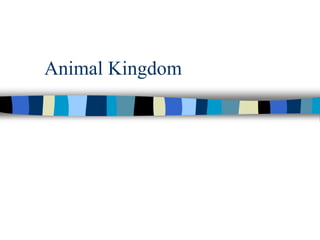
animal kingdom and its types folra fauna
- 2. Symmetry - None No general body plan or axis of symmetry
- 3. Symmetry - Radial Body parts repeat around the center of the body Bicycle wheel
- 4. Symmetry - Bilateral Only a single plane can divide the body into 2 equal halves
- 5. Body Plan Anterior – front Posterior – rear Dorsal – top Ventral – bottom
- 6. Porifera Examples – sponges Symmetry – none Digestion – Filter-feeding Other – Collar cells collect food as water filters through the sponge
- 7. Cnidaria Examples: jellyfish, sea anemone Symmetry: radial Digestion: 2-way Other: stinging cells (defense & feeding) diffuse nerve net
- 8. Platyhelminthes FLAT WORMS Examples – tape worm Symmetry – bilateral Digestion – 2-way Other – Eye spots – Concentration of nerves at head
- 9. Nematoda ROUND WORMS Examples – Heart worm, pin worm Symmetry – bilateral Digestion – 1-way Other
- 10. Annelida SEGMENTED WORMS Examples – Earthworm, leech Symmetry – bilateral Digestion – 1-way Other – Segmentation: made up of a linear series of repetitive body parts
- 11. Arthropoda Examples – centipede, insect, spider, crab, lobster Symmetry – bilateral Digestion – 1-way Other – Segmented – Exoskeleton made of chitin
- 12. Mollusca Examples – snail, squid, octopus, clam Symmetry – bilateral Digestion – 1-way Other – Mantle: creates shell – Well developed optics
- 13. Echinodermata Examples – sea star, sand dollar, sea urchin Symmetry – Bilateral (larvae) --> radial (adult) Digestion – 1-way (some become 2-way) Other – endoskeleton
- 14. Chordata Examples – fish, amphibian, reptile, bird, mammal Symmetry – bilateral Digestion – 1-way Other – Endoskeleton – Closed circulatory system
- 15. Chordata - cont’d 4 shared characteristics: – Dorsal nerve cord • brain & spine – Notochord • backbone – Gill slits • gills or lungs – Post-anal tail Exothermic: “cold-blooded” -body temp is regulated by external environment Endothermic: “warm-blooded” -maintain body temp by converting food to heat
- 17. Agnatha - jawless fish
- 18. Chondrichthyes Body temp – Exothermic – Some homeothermic? Heart – 2-chambers Respiration – Gills Fertilization – External or internal Other – Skeleton = cartilage • Inhibits tumor growth? – Some lay eggs, some give live birth – Large, oily liver helps with bouyancy
- 19. Osteichthyes Body temp – exothermic Heart – 2-chambers Respiration – gills Fertilization – External (sperm & egg meet outside the body) Other – Swim bladder – Lateral line system
- 20. Amphibian Body temp – exothermic Heart – 3-chambers Respiration – gills, skin, lungs Fertilization – external Other – Adapted to life in & out of water – All must return to water for reproduction
- 21. Reptiles Body temp Heart – Exothermic - 3-chambers (crocs = 4-chambers) Respiration Fertilization – Lungs - internal (sperm+egg meet inside the body) Other : internal fertilization – Makes return to water unnecessary – Provides better protection for sperm – Do not need to lay as many eggs
- 22. Amniotic Egg Reptiles first to introduce amniotic egg – Yolk = food for embryo – Allantois = collects waste – Chorion = allows gas exchange – Shell = protection *Prevents embryo from drying out
- 24. Aves (aka Birds) Body temp – endothermic Heart – 4-chambers Respiration – lungs (very efficient) Fertilization – internal Other – Eggs must be incubated – Adapted for flight …..
- 25. Adaptation for flight Decreased body weight Feathers Hollow bones No teeth Strong muscles Excrete highly concentrated urine with very little water (uric acid)
- 27. Mammals Body temp – endothermic Heart – 4-chambers Respiration – lungs Fertilization – internal Other – Hair, fur, or vestiges – Mammary glands – Largest, developed brains – Specialized teeth – Increased parental care
- 28. Monotremes Reproduce by laying eggs Platypus, echidna
- 29. Marsupials Give birth to small, immature young that further develop inside an external pouch Kangaroo, koala
- 30. Placenta Young develop inside mother’s body until birth 95% of all mammals are placental
- 31. The End